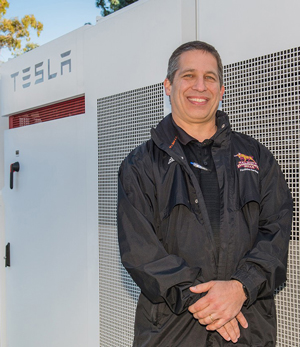Newswise — Sustainability and eco-friendly initiatives take center stage around the world this month, leading up to Earth Day on April 22. At the California State University, though, innovative efforts to make our campuses greener and more efficient are happening every day.
The just-released 2018 CSU Sustainability Report examined our progress against 14 sustainability goals set in 2014 by the CSU Board of Trustees.
The findings, which cover 2014 to 2017, show that the CSU has already exceeded the 2020 goal for reducing greenhouse gas emissions as well as the target to reduce water use by 10 percent by 2016.

In recognition of Earth Month, here's a round-up of just a few eco-friendly feats worth celebrating at the CSU:
- CSU Bakersfield received a $500,000 donation in March 2018 to support its proposed Energy and Innovation Center, which will house the Department of Physics and Engineering, the California Energy Research Center, the Fab Lab, and the School of Natural Sciences.
- The Campus as a Living Lab (CALL) program integrates sustainability into academic programs across the CSU. Currently, there are projects at 11 campuses — Channel Islands, Dominguez Hills, East Bay, Humboldt, Long Beach, Los Angeles, Monterey Bay, Northridge, Pomona, Sacramento, and San Marcos. Students learn how to solve real-world problems related to climate change and environmental issues.
- CSU Chico recently hosted its 13th annual "This Way to Sustainability" conference — the largest student-run sustainability conference in the nation.
 CSU Dominguez Hills is one of the first to participate in an innovative load relief program. As part of its partnership with Tesla, 20 large battery packs were recently installed on the campus. Photo courtesy of CSU Dominguez Hills
CSU Dominguez Hills is one of the first to participate in an innovative load relief program. As part of its partnership with Tesla, 20 large battery packs were recently installed on the campus. Photo courtesy of CSU Dominguez Hills - CSU Dominguez Hills is reducing its energy dependency with an innovative "virtual power grid" composed of 20 large Tesla battery banks supported byartificial intelligence.
- CSU East Bay launched a successful "solar suitcase" pilot course that recently expanded to San Francisco State and three other CSU campuses. The program, which partners with Pacific Gas & Electric, allows CSU students to teach middle-schoolers about generating clean electricity and environmental and social justice. The "suitcases" use the sun's rays to make power that can run medical equipment, lights and water purifiers in developing countries.
- CSU Fullerton's award-winning Urban Agriculture Community-Based Research Experience (U-ACRE) program gives students experiential learning opportunities that address sustainability in the context of food security.
- Humboldt State's Schatz Energy Research Center, which designs and deploys clean energy technologies and supports research, has launched the Blue Lake Rancheria (BLR) project, designed to power critical infrastructure for the BLR tribal community and the Humboldt County region.
- Cal State LA continues its groundbreaking green efforts with the Hydrogen Research and Fueling Station, the first fueling station in the world to sell hydrogen by the kilogram directly to retail customers.
- Cal Maritime is upgrading its marine fleet vessels to reduce greenhouse gas emissions and other air pollutants.
- CSU Monterey Bay was the first CSU campus to integrate carbon neutrality goals into its physical master plan update.
- CSU Northridge introduced its new Associated Students Sustainability Center in November 2017. The LEED Platinum-certified building is the new home of CSUN's Institute for Sustainability.
- Sacramento State's Closed Loop program, launched in 2015, turns food waste and landscaping waste into mulch, compost and renewable fuel, has won multiple awards. In 2017, nearly 63 tons of food scraps from the campus' Dining Commons were converted into bio-compacted natural gas to run a fleet of campus shuttles.
- CSU San Bernardino launched its Resilient CSUSB Plan in fall 2017, which offers a road map for building, operating and nurturing a healthy, more resilient community.
- San Diego State is embarking on extensive research to restore the health of the San Diego River, a project with plans to develop a 50-acre community river park.
- San Francisco State's Office of Sustainability offers an online, interactive Energy Dashboard, highlighting the campus's electric, energy, natural gas and water consumption.
- San José State's Mineta Transportation Institute was recently selected to lead the California State Transportation Consortium in partnership with CSU Chico, Fresno State and CSU Long Beach.
- Cal Poly San Luis Obispo recently announced the completion of its new 18.5-acre solar farm, which will generate up to 25 percent of the campus's electricity, saving about $10 million over 20 years.
- Stanislaus State offers a sustainable agriculture emphasis, which provides a learning opportunities for design approach in agro-ecosystems.
- Sonoma State introduced its "Sustainability in the Classroom" initiative, which aims to boost the number of sustainability-related course offerings.
Learn more about how CSU campuses are working toward a more sustainable future.
